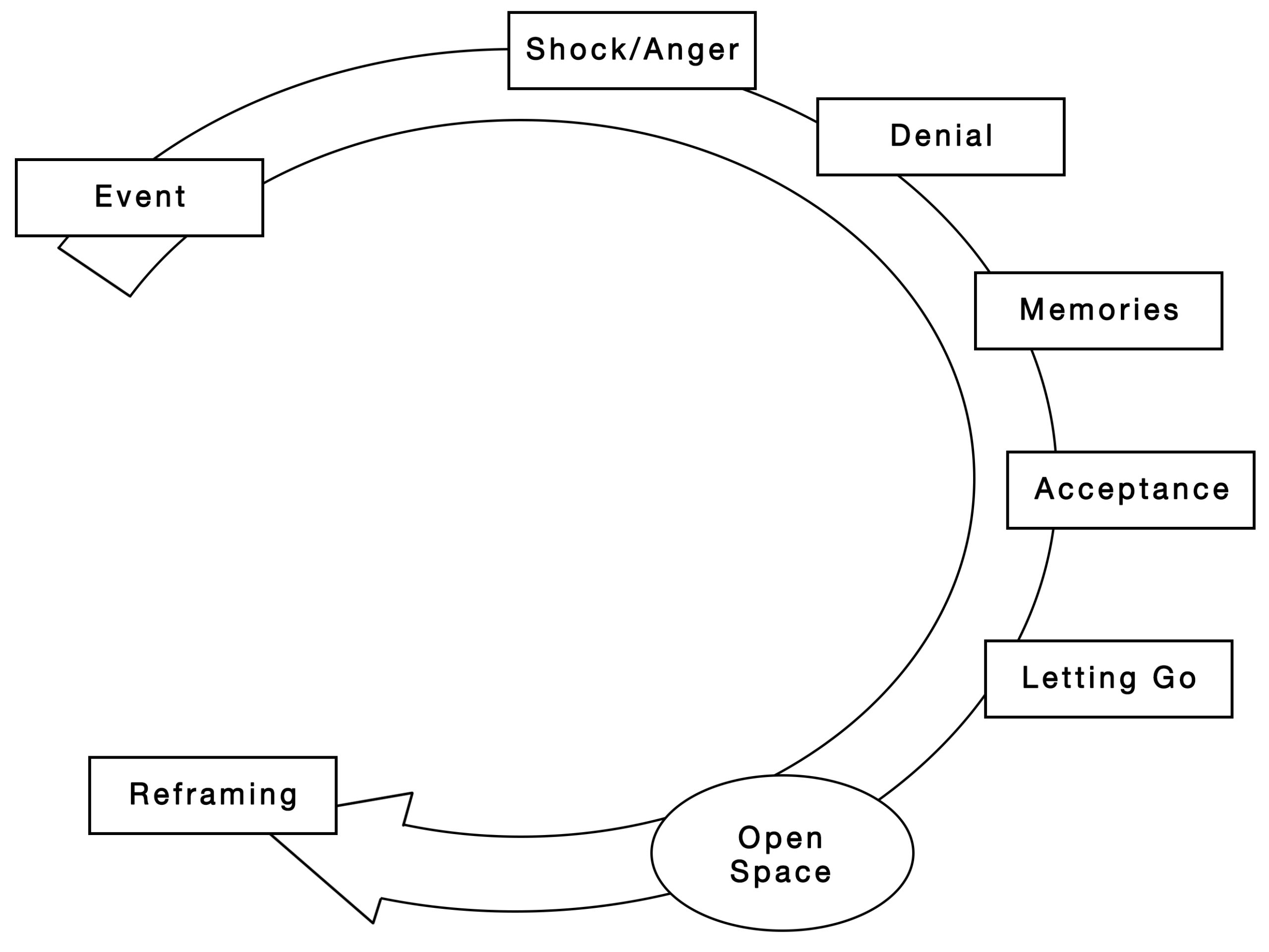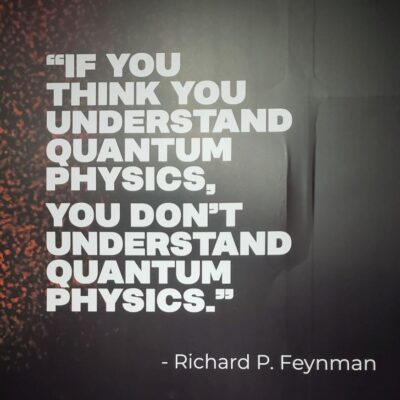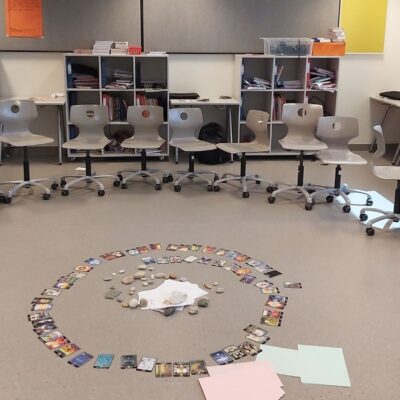
Enter into a contract with a facilitator who is skilled not only in facilitating a Whole Person Process facilitated meeting but also in working with WPPF for the longer-term benefit of your organization from even a single meeting. The contract will include provisions for a planning meeting, the WPPF meeting, and a de-brief meeting.
Grief work is part of everyday life. Change is constant and change is always accompanied by loss. When there is loss, the human being goes through a cycle of grieving before being able to move on to the future. The grieving cycle that the human goes through, part of the cycle of transformation, is part of the way that humans cope with loss. Through the grief work, human beings heal, accept change, and move on. Often, in an organization, what is labeled as ‘resistance’ to change is not resistance at all but a demonstration of the stage of grieving that the person is experiencing.
In experiencing life and life within organizations (business, community, family), it is best to assume that everyone is always grieving about something. Everyone is at different stages of grief about different situations to do with work and to do with their personal lives. If you make this assumption, you are more likely to pay attention to the grieving that is going on which is likely to change some of your approaches to people and is likely to change some of your conclusions about people and their behavior. When all people within your organization are oriented to the role of grief work at work, a powerful change takes place within the organization. People become less judgmental of one another and indeed, become more compassionate. The tangible result is a reduction of conflict. People who become oriented to the work of grief at work report back to us that they take this knowledge home and it fosters conversations that result in improvements in family life too.
There has been a lot of research done about humans working through grief. The most quoted research regarding grief cycle work is by Elisabeth Kubler-Ross and can be studied in a number of her books including her best-selling book On Death and Dying. In the 1980s, people studying how organizations transform recognized that what they were finding was that part of the cycle of transformation was actually the cycle of grief and that no cycle of transformation to a new higher state happened without going through the grief cycle. The model of the grief cycle that we suggest for your use was developed by Harrison Owen, creator of the meeting methodology Open Space Technology, based on the work of Elisabeth Kubler-Ross.
Although oversimplified, this diagram provides a view of components of the grief cycle. An event happens. I used to think that it needed to be an unhappy event because I had only read about grief work in relation to unhappy events of loss. Over the years, it has become apparent to me that any event that brings about change is an event from which grief work begins. Change, even due to a happy event, is accompanied by loss of something. Following the event, the person goes through stages including shock/anger, denial, memories, acceptance that there is no going back and then a letting go of attachment to the past.
The simple version of the grief cycle in the diagram does well in working with the grief cycle in organizations. The grief cycle begins when an event happens. It could be an event such as downsizing, retirement of a favorite employee, or loss of a major contract. It could also be an event such as gaining a huge new contract that will triple the size of the organization, the advent of a new CEO who appears capable of leading the organization to great new success or moving to a new better building. The event could be a sad event or a happy event. Both types of events mean that change is happening, and with change, there is always loss. The loss may be of something that was treasured, or the loss may be of something that was despised. In either case, there is loss, and the work of grief starts.
First there is a reaction, something like “oh shit”, expressing shock/surprise or anger. In those moments of an announcement, something like “oh darn” just does not express the feeling. The next phase of grief work is usually denial, in which the person involved somehow keeps behaving as though the event did not happen. This might be procrastination taking the form of busywork just to stay busy. It might be a refusal to talk about what has happened. The person in denial does not consciously know that he or she is in denial. Then, if all goes well in this grief cycle work, the next stage is one of memories.
Memories is a misunderstood stage. During memories, the person talks about things of the past starting sentences with something like “do you remember when…?”. This can sound monotonous to the listener who has already moved beyond memories work and ends up hearing the stories, maybe more than once. This stage is generally misunderstood because the listener often concludes that the person telling the stories of the past just cannot get on with the new or is a resister to change. In fact, what is happening is the stage of grief work just before the stage of accepting that the past is no more.
A word of caution here: the diagram is drawn in a linear way as though one stage happens after another, and in some ways that is true. However, people can cycle back beginning at shock/surprise and anger going on to denial and then back again to shock/surprise and anger. It is such a good sign when memories work starts because the ‘stuckness’ of the shock/surprise and anger through to denial and back again cycle is usually done by then. People can also get stuck at a stage such as denial, even for as long as a lifetime.
In organizations, a frequent error is accusing someone who is doing their ‘memories’ work as being a ‘resister to change’. This accusation, and often with an accompanying reprimand from management, is the new event that initiates the stages of the grief cycle over again. The person who was just about to let go of the past and get on with the new now needs to go through the cycle again. In organizations that understand how to work with the grief cycle, the person is supported to move through the grief cycle moving on to the new change conscious of the process he or she is going through as normal. The impact for working with change in the organization is dramatic.
Now back to the diagram. Following memories, the next stage is accepting that the past is now in the past, and there is a letting go that happens, as the person detaches from the past, willing to face the present as it is, and with a willingness to head into the future. Harrison Owen, developer of a meeting methodology called Open Space Technology, noted that the next stage in the cycle of healing was to provide lots of open space for people to use their creativity, wonder, imagination, and inspiration as they developed plans for the future. By the way, if the organization has recently gone through the stages of grief work and is now at this open space, it is a great time to use the meeting methodology Open Space Technology in a meeting to explore the opportunities for the future. In organizational transformation work, following this period of open space, reframing occurs, a new plan is implemented, fine-tuned, and managed. Those of us who work a lot with Open Space Technology encourage organizations to give as much space as possible during the phase of dreaming/designing of the future. Investment in this time, at this critical moment in the grief/healing cycle pays large dividends in the future.
This completes the brief explanation that would give your management team an orientation to the grief cycle that is sufficient for them to be able to explain it to others. It is interesting to ask your team to indicate where on the grief cycle they each believe the organization is. This generally results in an interesting discussion. An additional and generally illuminating discussion occurs if the managers are also asked to identify where each of them is in the grief cycle regarding the organization. This is not a scientific survey by any means, but it is a starting point for self-awareness regarding the effects of grief in relation to change in the organization.
Working with the Grief Cycle Diagram within Teams
The organization will benefit greatly if the managers in turn take their teams through the grief cycle diagram, orienting them to the cycle and also engaging in discussion of where in the grief cycle the people felt that the organization was, and where they each were in their own grief cycle work regarding the organization. The discussions bring self-awareness throughout the organization regarding grief at work; they provide a concept and language for the people to use in talking with one another, with their teams, and within the broader organization; and they have the result of shifting from a judgmental perspective about each other to a perspective of tolerance and compassion.
When the people within an organization know that grief work is going on, it is of great help amongst the managers, staff, and teams because, in a very simple way, it assists them in greater self-awareness and consciousness about their own processes. It assists in the development of greater compassion for one another, and development of the capacity to set judgment aside in favor of looking at what might really be going on. This simple framework and its use provides those involved with a different lens to view what might be happening, with the likelihood that destructive conclusions about ‘resistance to change’ are set aside in favor of more constructive conclusions.
Once the orientation to the grief cycle is complete, and initial discussions have taken place, the organization can use the grief cycle as one of the frameworks to achieve and then sustain a healthy and balanced interior terrain. The topic of the grief cycle can weave itself into staff meetings, enabling crucial conversations about working with change that would not normally take place within a meeting.
Different people go through the cycle of grieving at different speeds. The same person goes through the cycle of grieving at different speeds for different events. When staff teams discuss this, they identify that it has been difficult in the past for those who are ready to move forward to cope with those who appeared to be resisting change. Following introduction of the grief cycle, the discussion includes the likelihood that what was going on was just different speeds of getting through the grieving. People who have found themselves in anger and denial who are working with people who are reframing for the future also find it very difficult to be with their team members. Again, the discussions about the cycle of grieving brings an awareness to the team of what is happening from the grief cycle perspective. Those in anger and denial can simply say to those who are running quickly to the future to slow down and give them a chance to get through their grieving, so that they can all move forward as a team.
I have had staff teams have major breakthroughs in their teamwork as a result of such discussions, with those who wish to process their grief asking the others to give them at least twenty-four hours before having a discussion about the future. Twenty-four hours is not a lot of time, but it seems that acknowledging the right to this time has had profound effects. And those who were ready to forge ahead realize that they did their grief work more quickly and they tend to be willing to postpone the discussions about the future for a little while so that all can move forward as a team.
From time to time, someone in the team is really stuck in grief with an inability to move forward with the team. The person can appear as though he or she is resistant to change when in reality the person is stuck in a stage of grief work. Discussion about grief work does not ensure that everyone will get unstuck and move forward. Sometimes, the rest of the team moves forward without that person with the hope that the person will move forward with time. It is a good idea to engage a coach for a person who is having difficulty, with the coach working based on knowledge that grief work is taking place. On occasion, it is not possible for the person to move beyond being stuck in a stage of grief, for example ‘anger’. There is a point where this cannot be solved by the team but becomes an issue for the manager and person to discuss regarding the terms of employment and explore options.
Using the cycle of grief to initiate conversation regarding the interior terrain
- Duplicate the diagram onto a piece of flip chart paper.
- Explain that all people are in grief about something all of the time, often about multiple things simultaneously to do with both work and personal life. It is part of how we heal.
- Give the simple explanation of the grief cycle.
- Ask those present to identify (possibly by posting sticky dots) where on the grief cycle they personally believe the organization as a whole is at.
- Discuss the results and any implications of this quick check of perceptions.
- Ask those present to identify where different departments/teams are regarding the grief cycle. Discuss the results and any implications of this quick check of perceptions.
- (optional) Ask those present to identify where they are individually regarding the grief cycle as it relates to the organization. Discuss the results and any implications.
- Within the team, check on grief work on a regular basis- weekly, monthly, quarterly.
Different Speeds of Going through the Grief Cycle has a Major Impact on Teams
In most organizations, those who are in leadership positions go through the grief cycle resulting from an event much earlier than their staff. This is usually because the leaders were aware of the changes sooner than the staff was made aware of them and indeed it may be that the leaders chose to initiate the event that. Healthier and more balanced organizational life results when leaders are aware of this and act accordingly.
People Cannot be Pushed or Pulled Through their Griefwork
People cannot be pushed or pulled through their stages of grieving. If they are in shock, anger or denial, they simply need to work their way through this and it happens naturally in most situations. Again, some people will get stuck in one of these stages but unfortunately the net effect of trying to push or pull them results in a new event being created, and a cycling back to shock and anger. On an individual level, if the person wants to, the person can receive assistance to cope with loss through the healing arts and through bereavement groups. An organization can make options available to people. Change with its accompanying loss and then grief cycle work in an organization involves more than a single individual.
Many people, whole teams, and even the whole organization might be experiencing grief cycle work over the same incident. To assist movement through the grief cycle in organizations, the best and most successful option is to offer the opportunity to do memories work. Those who are in the stage of memories will then be able to move on to the letting go, and many of those who are in anger/shock or denial participate in the memories work and also move on toward letting go. They are neither pushed nor pulled (remember that neither pushing nor pulling works) but rather are presented with an opportunity that they have choice about taking advantage of.
Using storytelling to assist people in moving forward in their grief cycle (Option 1)
This format can be done in as little as an hour although three hours is ideal.
- The room should be set up with chairs in circles of four’s, five’s, or sixes. No tables.
- A facilitator sets the tone and gives the instructions. In introducing the exercise, normalize that there will be that which we are happy about and that which we are not and that this is all part of the story and so it is important.
- Participants in each conversation group to share stories with each other about the organization that include stories about which they are glad, mad, or sad.
- Participants to write down glads/sads/mads on flipchart paper for sharing with the larger group later. An alternative to glads/sads/mads is accomplishments and struggles. This alternative will take the group basically to the same place. Allow an hour for the sharing but if time is restricted, this can be effective in as short a time as twenty minutes.
- Have participants move their chairs to create a large circle or concentric circles.
- One spokesperson from each group is to share the highlights of the stories from their group, without repeating highlights told by a previous group (ie: no duplications in the larger group sharing time). This can take about an hour, dependent on group size but instructions can be given to limit the time if needed and it still works.
- The facilitator of the meeting to ask in the larger group if there are any more stories that have not yet been captured that anyone wishes to tell.
- These stories might take up to an hour.
Using storytelling to assist people in moving forward in their grief cycle (Option 2)
This second option allows everyone to hear all stories which is of benefit to the group consciousness, takes about three hours, and works well in groups up to about sixty people.
- The room should be set up with chairs in a circle. No tables.
- A facilitator sets the tone and gives the instructions. In introducing the exercise, normalize that there will be that which we are happy about and that which we are not and that this is all part of the story and so it is important.
- Participants are shown an object such as a microphone, or a stone, or a flower and told that whoever holds the object is the speaker and that all of the rest are the respectful listeners. This is not a process for conversation but for speaking with respectful listening, providing people with the opportunity to be heard and understood (two key ingredients that assist people in moving forward).
- Participants are told that the object will be placed in the center of the circle and that anyone at any time can go to the center to get the object, and as the holder of the object to tell whatever story that they care to again stressing that all stories are welcome, whether they are happy, sad or angry stories. The emphasis is on honoring the past and the present of the organization before moving on to the future.
- Participants can speak from the center, from their chair, or from moving around within the circle. All is fine, with the only requirement being to hold the object.
- The facilitator never intervenes. Once it appears that all of the stories that anyone cares to share have been told, the facilitator takes up the object, states that the story sharing appears to be over, but just in case it is not, a moment of silence will continue so that anyone who is still collecting their thoughts has the opportunity to share. The facilitator places the object back into the center. And when it is clear, after maybe a few more stories, that the sharing is done, the facilitator takes up the object and while holding it thanks all for their participation.
The method to assist in memories work is to offer opportunities for storytelling as a regular and important part of organizational life. The time invested in story telling will pay for itself over and over again in reduced conflicts, greater productivity, and healthier teams that really communicate for optimal team performance. To get this going, there needs to be an invitation to an initial storytelling afternoon or evening, for the whole organization or for a team. The invitation may cause some sense of disbelief that this is a useful part of the workday. The invitation should not say anything about the memories part of the grief cycle. It is helpful if it isn’t even called a story telling session. Instead, the invitation is to a time of ‘honoring the stories of the past and the present of the organization’. Have refreshments available. Artifacts about the organization that are appropriate can be brought into the meeting room, including items such as pictures, architectural designs, and mascots.
It is not appropriate to set a tone of celebration with decorating because this might close the space and silence people who are wanting to tell stories about which they are sad or mad. A common mistake of leaders/facilitators is to attempt to create a positive tone, only allowing for good news items. This is not a time to use the meeting methodology Appreciative Inquiry that gets at the core strengths of the organization and things to be appreciated. This does not enable people to move forward in the grief cycle towards embracing the future because allowance needs to be made for the telling of all kinds of stories. For the initial storytelling afternoon or evening, about three hours is needed.
Storytelling can be used to assist in grief cycle work in teams or as a whole organization not just once, but on a regular basis as an integral part of business. Different teams will develop their own schedule for specific times set aside for storytelling. The time for a story telling event after the first one is done is likely to be much shorter. One idea that works well is for each team to have a weekly story telling circle, using the second format outlined here at the start of the regular weekly team meeting. If at least thirty minutes of time is allotted, it would be effective. Team leaders could assist each other by taking on the role of facilitator for each other’s team story telling time.
In addition, having an annual story telling time for the whole organization assists the individuals involved in moving forward. Positioning this just before the annual strategic planning or direction setting meeting is the most effective, so that the past and present can be honored before moving on to the future. If this is done, more of the participants are in readiness to be creative in their ideas and solutions for the future. This is because they have had the opportunity to move forward in their grief cycle work regarding the organization and are in the letting go of the past stage of the cycle rather than being stuck in their anger or denial or the need to share their memories. This enables organizational readiness for intentional change work.
Even the change work that you are undertaking in working to achieve organizational health and balance will result in loss of what was in place before, and although there is a commitment to reaching health and balance, there will also be grieving going on about what is lost, even if what is lost is very life depleting. Bringing the grief cycle to the attention of all participants in the organization and to offer opportunities for story telling as outlined above helps with healing.
Not all grief will dissipate because of a story telling event. Some grief is sorrow held so deeply in the heart that it cannot be touched even by story sharing. Much grief in an organization is sorrow that is held in the mind and reworked. This has a good chance of being dissipated during story sharing, during the opportunity to share memories. However, one of the few resources available to people in organizations to move beyond the past and head into the new is the healing salve of story telling.
Author
-

Birgitt, as well as being a Co-owner, is a Co-founder of the Genuine Contact program. She is an international management and organizational solutions consultant, author, meeting facilitator, teacher, and executive coach. Visit her website for more information.
View all posts









Mohamed Salifou
Very nice and helpful piece!